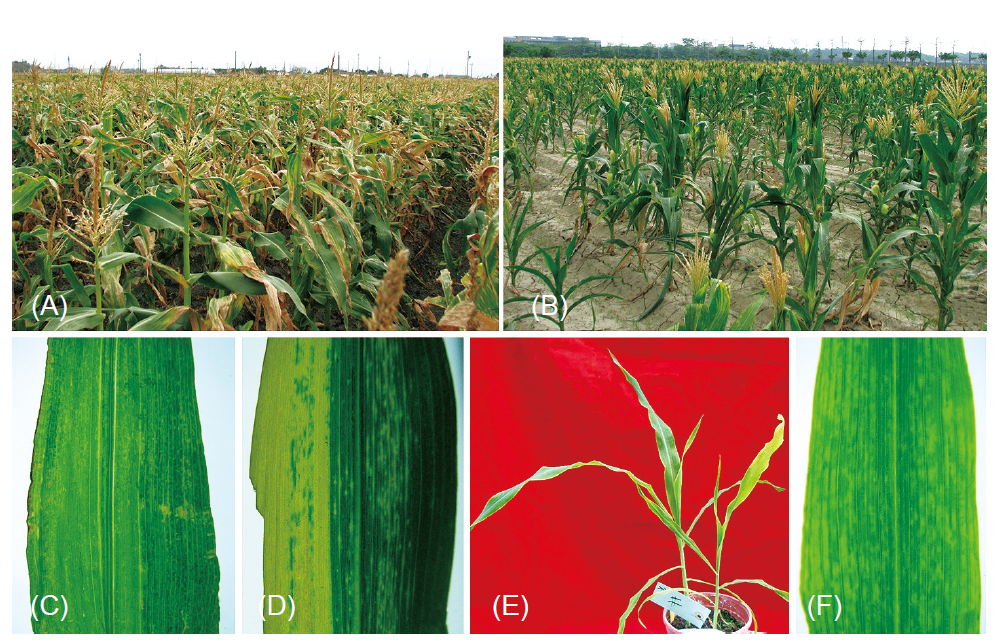All issues

Author:Chien-Ming Chou, Chun-Tao Chen, Yi-Hsuan Chien, Chin-Hui Tsai, Chin-Chih Chen, Feng-Chyi Lin, Yi-Ju Chen, and Ting-Ching Deng*
Abstract:
Maize samples showing chlorotic, yellowing and leaf necrosis symptoms were collected in Huwei Township, Yunlin County in February 2014. After inoculation by leaf sap, the similar chlorotic mottle symptom was developed on sweet corn cv. ‘Honey-236’ and a pure virus isolate “NFU2” was obtained from infected sweet corn by a serial inoculation. The total RNA of “NFU2” isolate was extracted to conduct a reverse transcriptase polymerase chain reaction (RT-PCR) with the degenerate primer (Tenui-DF1/Tenui-DR1) and that yields a 1.4 kb product. The product could combine into one single contig, and this contig shared 99% sequence identities with Chinese Maize chlorotic mottle virus (MCMV) “Yunnan3” (Acc. No. JQ982469). The complete sequence of MCMV “NFU2” was as 4,436 nucleotides. Through whole genome sequence alignment and phylogenetic analysis revealed that MCMV could be divided into four groups, including American isolates, Chinese isolates, African isolates and Taiwanese isolate. Phylogenetic analysis with nucleotide sequences of MCMV coat protein showed that MCMV isolates which were prevalent in Asia and Africa in recent years could possibly share the common ancestor of MCMV from Thailand. MCMV coat protein sequence was constructed into expression system of Escherichia coli Rosetta strain and the expressed viral coat protein was purified for antiserum production. Homemade MCMV antiserum could be used in enzyme-linked immunosorbent assay (ELISA) for MCMV detection in field samples. Furthermore, based on MCMV coat protein gene, a specific primer pair (MCMV-g3514F/MCMV-g4014R) for RT-PCR was developed, and by which the MCMV could be detected from a single maize thrip (Frankliniella williamsi Hood). These detection tools are available for further study of insect transmission mechanism of MCMV. Survey of 306 maize samples in Taiwan from 2014 to 2015 by indirect ELISA using antibodies against MCMV and/or Sugarcane mosaic virus (SCMV). The results indicated that incidence of MCMV reached 79.7% and maize lethal necrosis (MLN) caused by MCMV and SCMV reached 31.7%. Maize samples including sweet corns, white corns, waxy corns, forage corns and dent corns were all MCMV-infected. Sweet corn cv. ‘Bright Jean’ has the lower incidence (60%) among the green corn and comparing with incidence 31.6% of forage corn and dent corn. This is the first report about complete genome sequence, phylogenetic analysis, detection reagent development and field survey of MCMV infecting maize in Taiwan.
Key words:Maize chlorotic mottle virus, Sugarcane mosaic virus, Phylogenetic analysis, Detection reagent, Field survey
Download:![]() PDF Links
PDF Links
- 1. Development of Tractor-Mounted Seedling Transplanter for Sweet Potato
- 2. Synergistic Effect of Additional Gas on the Toxicity of Phosphine to Sitophilus oryzae and Sitophilus zeamais (Coleoptera: Dryophthoridae)
- 3. Effects of Temperature and Solar Radiation on Growth Traits and Plant Elements in Purple Leafy Sweet Potato
 Submit your manuscript
Submit your manuscript
 Guide for authors
Guide for authors